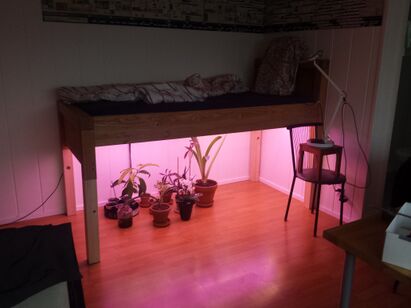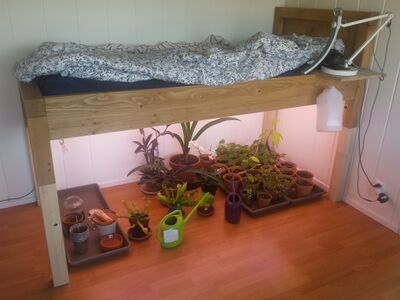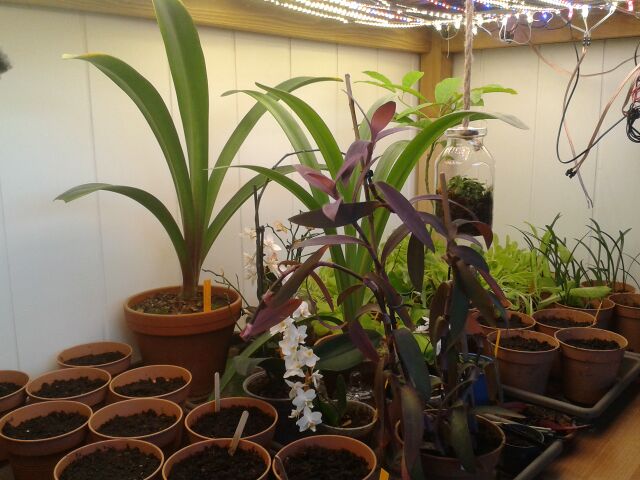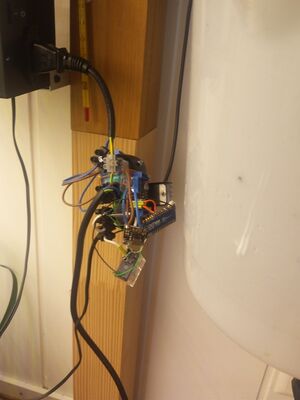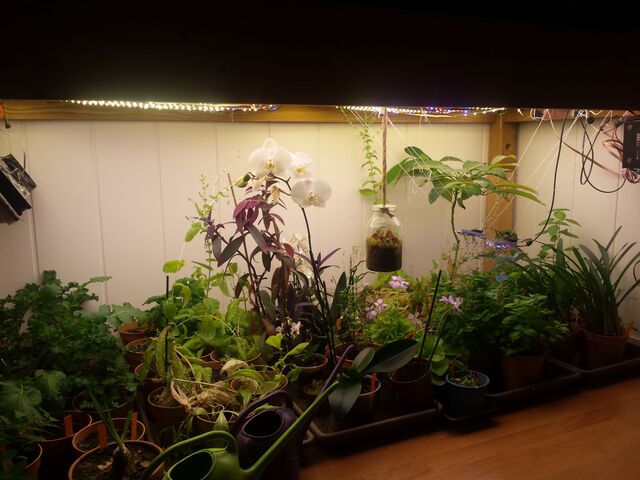Plants: Difference between revisions
(→2023-03: add gallery) |
(→2023-04: add gallery) |
||
| Line 574: | Line 574: | ||
Also because of that, bootup timings are now longer (10s) to be gentler on the PSU. | Also because of that, bootup timings are now longer (10s) to be gentler on the PSU. | ||
[[File:2023-04.svg|alt=wiring diagram|612x612px]] | [[File:2023-04.svg|alt=wiring diagram|612x612px]]<gallery> | ||
File:IMG 20230407 091033.jpg|alt=pinguicula has a lot to eat|pinguicula has a lot to eat | |||
File:IMG 20230414 085106.jpg|alt=cephalotus trap macro shot|cephalotus trap macro shot | |||
File:IMG 20230416 171346.jpg|alt=strelitzia reginae repotted for deeper roots|strelitzia reginae repotted for deeper roots | |||
File:IMG 20230426 091723.jpg|alt=drosera, pinguiculas|drosera, pinguiculas | |||
</gallery> | |||
==== 2023-05 ==== | ==== 2023-05 ==== | ||
Revision as of 07:42, 20 May 2023
2021
2021-02-12
Bought legs (250cm/4= ) 62.5cm and screws, and built the frame to elevate the bed by 62.5cm. The idea mostly comes from the gained experience and success of smaller-scale artificial illumination projects :
- 2019-07 to 2019-09: A two-spot ordinary reading lamp to augment sunlight in a dark spot as part of a aeroponics project in a bucket with greenhouse film to isolate the mist-ified root system from the outer environment.
- 2019-09 to 2020-08: A muliple led-strip setup as a bigger continuation of the previous project, in a total of four rectangular boxes with one 5 meter strip for lighting.
The motivation was because of a growing plant collection and a not satisfactory almost only north facing set of windows. The plants were only growing slowly.
Also did some lighting, added :
- 3:1/red:blue 10m strip, so in 5x 2m parts.
- 3m double warm white:cold white about 12-24W strip in one 2m strip and joined 1m with next strip:
- Old led strips are repurposed too, one 12W 5m in two 2m strips and 1m joined with the above.
The current wiring is power accross a 11m long DC wire, all strip terminations are in parallel on the legs end of the bed.
2021-02-16
Bought three 95*37cm rectangular underpots and some corresponding standard-sized pots to fit in them, 12 pots per underpot and there is place for 5 underpots. Most plants from the window are now under the gardenbed. Also bought some more standard pots and some soil.
2021-03
Progress on some vegetable (zucchini) seedlings, and planted some garlic too, which sprouted. The lemon seedling from 2020 though seems dry.
2021-04
The little orchids attached to the mother plant have started flowering on themselves. The Amaryllis seeds have successfullt sprouted. The garlic has dried out and died.
Bought 20m of high power light strips to extend the lighting and balance it a bit more to the white. It also now takes about twice as much power.
There are now ventilation fans on the legs end of the bed, for cooling the lightstrips and also providing some ventilation to the plants, preventing stale air.
2021-05
Added some more fans to the ventilation. Changed out the 11m cable for a thicker 2.5mm2, allowing more power and therefore more brightness.
2021-06
Bought some more standard pots.
2021-09
Added some foam behind the ventilation fans to filter the air a bit. Bought more standard pots and soil.
The white orchid had three little offshoots, two of which were big enough so I separated and repotted them. This was while flowering so they may be pertubed a bit.
Major rewiring on the electronics side, the following changes were made:
- swap around side of lights: head end of bed is now where the strips are connected
- disconnect 11m 2.5mm2 thick wire and swap it out for a two-step transistor+relay system: the power supply now is at the nearest outlet to the strip connections and there is a thin 11m wire that only carries a 3.3v (10mA maybe?) signal, which controls a 12v relay switching the AC, through a 12v transistor
All this increased brightness noticeably, measurements: 11.4V 10A (=114W) before rewiring and at PSU end, only 9V at LEDs end. After: 10.5V 20A (=210W).
2021-10
There were two power bottlenecks that became obvious on the wiring change :
- There were two relays in parallel (for the 10A current) switching on the DC side. The wiring to them was a part of the bottleneck so I moved them over to the AC side and they completely connect/disconnect the PSU. Now a single one is enough, as they are rated 30A, and @220vAC it is 1-2A.
- The direct connections from the PSU to the LEDs now carry more current and therefore heat up noticeably (30°C everywhere). I changed most PSU-LEDs wires out for thicker 4mm2 speakerwires (nothing else available was ≥4mm2), for a majority of the distance (about 1m in the longest case) and split up the shorter wires at the ends to not be longer than 10cm, and to generally not carry more current than for three 2m strips at a time.
2021-10-10
Seeded a lot, somewhat to clean up seed reserves (for fear of reaching expiration dates). They are:
- green kale (plants entire 06)
- spinach (plants entire 05)
- miscellaneous/rare seeds: passiflora edulis, passiflora coerulea, strelitzia reaginae and Violette Glocke (plants entire 06)
- basil (plants entire 02)
2021-10-16
2021-10-29
Because of the recent power increase, and therefore more brightness, one weak point became noitceable: the internal resistance of the strips themselves accross 2m. They heat up considerably, though not dangerously, and are dimmer at the not-connected end. To remedy this, simply replacing, or instead shoring out the strips with thicker conductors than they have internally should lower the total resistance and allow cooler and brighter functionning. Furthermore, adding a second power connection accross a 2m strip would be most optimal at the 2/3 mark from the connected end, meaning any power travels 1/3 of 2m for the farthest, a 3x increase from the previous 2m farthest with adding only one more connection along the length. The 4mm2 cables were used for these connections, necessitating a 16mm2 domino at the power supply to connect everything.
2021-11
Bought two 50x16cm rectangular underpots to fill the remaining gap. There are now carnivorous plants in the forward one, the backward one is empty for now.
2022
2022-01
A few changes since 2021-11, they are:
- UV lights experiment: bought 5x 365nm and 5x 380nm leds, they are mounted on coolers with fans and are a bit dim so quite near to the plants.
- Both amaryllis overwintered in the cold and dark, though not freezing.
- Strelitzia reaginae is the only plant that sprouted from the rare and date-expired remaining seeds, and even there only one plant of 4-5 seeds. The Violette Glocke also sprouted but it was before its expiration date.
- Electronics: added some, 10W total, dimming lights for a more soothing sunrise experience than an instantaneous (or about 0.2s) turning on: a 10min slow dim up of some little led lights, only after that do the main lights turn on. This is not for the plants but for the comfort of the narrator, see a picture of these small lights in #2022-03.
- White rescued orchid was successfully fertilized and is forming a fruit.
Probably started to regularly fertilize some plants, to compensate that they are in pots and to boost yields. The fertilizer is an aeroponic tomato mix of several mineral powders/salts which are dissolved in warm water.
2022-02
The mystery amaryllis did make leaves this season but it does not make a flower spike. Brought in a new amaryllis, a white one. It has finished flowering but has weakened: it had little water and sun and bloomed two spikes from hormones from the store. The spikes I cut, and it has four green leaves.
The mint brought from france seems to have some kind of fungus parasite. To stop it proliferating, I take cuttings and plant those once they have roots.
2022-03
Repotted the strelitzia because it seems to have a carrot-like central root and was reaching the bottom of its current pot. It now is in a square green high pot. Bought the violet orchid.
Seeded lettuce to test whether this lettuce too wil be as floppy and acid as the previous one. In the worst case it is to use up the seeds.
2022-04
The lettuce is doing the same thing as the previous one, I think now that it is beacuse of lighting: there is not enough of it for lettuce. As a little surprise, the red amaryllis is making two new leaves after having bloomed. On the other hand, the white amaryllis seems to support the lighting but it dried one leaf off. The infested basil did not survive the outside, now putting the pots inside to at least try, and check they do not contain any greenflies. Will probably start over with new basil plants.
2022-05
Switched illumination settings to flip the year: instead of the longest day on 21jun and shortest on 21dec, now the shortest day is jun21 (06:20-18:30) and the longest will be 21dec (06:20-21:00). This is to heat less in summer and to light more in winter (better mood for me). Because of heat from the lighting among others, I bought an air conditionning unit to cool down during the hottest days. This should also help the sensitive plants like miltoniopsis.
2022-06
Seeded a basil "big-leafed" variety, now to see that it doesn't get infested with greenflies.
Put one pot of lettuce outside on the kitchen west window. It is liking it and takes on a more lettuce-like shape and is stronger, the leaves taste less acid and sweeter too.
Definite logkeeping start on 2022-06-23. Planted Apfelminze (probably Mentha suaveolens) from Omate, and also Melissa (probably Melissa officinalis). The lettuce ouside dried out, bringing it inside for now, but one basil that survived the cold april and may nights is still outside and flowering, it might not have any greenflies anymore.
2022-07
Bought new 400w PSU after the 5+years old one failed silently. Also wired a 3.3V and a 5V rail of the new PSU for the small UV leds (3.3V) and charging the photo-phone (5V).
The miltoniopsis suffered a bit from the heat I think (upwards of 28°C some days with night lows rarely below 20°C) and stopped flowering, though it already had the flowers open for its typical period. Brought the flowering basil inside as it seemed to not have any greenflies and was being eaten up by snails.
The big white orchid's fruit finally matured and burst. For now, I collected the dust-like seeds but I am not too interested in setting up an entire orchid growing facility, as it seems to be a quite labour intensive process to seed those.
2022-08
Changed some electronics because planning on adding more old-phones-as-cameras. Currently still only using one phone but the system will now easily work with multiple phones. Changed:
- Added a rasbperry pi (2) near the PSUs
- Replaced arduino by the raspberry pi. Because the raspberry pi and the phone charging were connected to the same 5v line as the arduino, it would sometimes not have enough power and reboot. That meant it thought it was morning and would take 10min to turn the main lights on again.
- Therefore all automated functions are run on the raspberry pi: turning main lights on/off, morning lights fade up, and calculating sunshine time (and therefore time synchronization).
- Because the rasbperry pi 2 does not have wifi, it has an external usb3 wifi antenna and corresponding drivers. It keeps wifi off most of the time, only turning it on once a day for uploading pictures. (On a reboot it will not turn wifi off, only the next day at 07:00 once the upload finishes). To schedule maintenance login, it checks that
rigel:/mnt/18a/plants/keeponlinedoes not exist and only then turns wifi off. if it exists, it keeps wifi on and a login will be subsequently possible. - Main rewiring of the led power behind the PSUs. Also changed mounting strategy for individual strips making maintenance easier because they are detachable. The wiring change is then some clean-up and extension all the way to the other end of the bed: the 1m modular multistrips have power connections on both ends, for avoiding too high voltage drops accross 1m length (just like power injection at the 2/3 mark of 2m strips to avoid dimmer ends of strips than their starts). It is now possible to attach/detach a multistrip easily: slide the set in a free space and then connect the wiring. No need to access from below, no need to screw in (just slide in), and all soldering can be done before connecting.
The basil seedlings are progressing and seeming healthy.
Doing a little experiment with two pots of mint, putting them up higher nearer to the lights. This is to see how they grow with more intense light and if it makes sense to split up some part of the gardenbed to be two-storied, as in make an about 30cm-high table and put plant trays on it. From below, it would have lights and more plant trays on the floor: two abut 30cm-high stories instead of one 60cm (with lights that far away, the plants are losing some light). The mint plants seem to be doing quite well and I am planning forward.
Most orchids have started to make new leaves or are continuing to grow new ones: the violet one, the yellow-bordeaux one, the two little white ones and also the big white one. The mother white one which still has a plantling attached also seems to do something at its stem, either a new plantling or just a new root or flower spike. Do they like the heat this much? It may also be because they were watered from below and left in 2cm water twice for more than a week each time.
The white amaryllis has dried all its leaves. I will unpot it and start its hibernation now, unfortunately in the fridge for its start; before something starts to rot and it definitely dies. The bulb is still stiff and with an earlier winter (now) it could make new leaves by october-november. About amaryllises, planning on repotting all the 2021 seedlings (some are 30cm high already) in one long rectangular pot and try to make a blooming cascade when they mature in a few years, by starting (potting in/pulling out of hibernation) every plant offset, by a week for example.
The parsnip grew well, but it had some insects, maybe some greenflies. To stop them I cut away everything green and only left its root stem sticking out the ground. That has started to make half a dozen green buds and leaves now, and does not have any parasites.
Bought a healthy Oncidium, also called Cambria, its flowers were bordeau, on discount because it had finished blooming. It it quite similar to the Miltoniopsis, also in growing conditions.
2022-09
Made multistrips of the remaining previous leds: some misc strips and the long-waiting UV led strips. They are now installed and wired up.
Measured the power use:
- AC: (235±0.5)V ac, (2.26±0.02)A ac ⇒ (531±6)W
- PSU_2(450w): (12.15±0.01)V 30.7±0.5)A ⇒ (373±6)W
- PSU_1(350w): (11.41±0.01)V (10.7±0.4)A ⇒ (122±5)W
for a total of (495±11)W and power factor in [0.901, 0.964]. Note that the two PSUs are not exactly connected on their 12V DC side, they connect to different sets of leds and any path from one to the other passes through a led strip: most strips have connections on both ends to prevent a too high voltage drop over 1m. When the inputs are shorted, I think PSU_2 takes over to 100% output and PSU_1 has no too much to do. PSU_2 is sensitive to its load and at 100% it ramps up its ventilation fan, which is too noisy and that is why I rewired it like that.
Did a table structure and now there is more space, for 24 standard pots in two x12 trays. The lights below the table are not yet mounted so there are no plants there. Replanted the amaryllis plants (seeded 2021) from 4 standard pots into a rectangular 17x60cm and four standard pots. The biggest bulbs are already 6-8cm diameter, there are about 10 that are >5cm and 25 in total, with only about 5 smaller than 2cm. When they will be mature for flowering, I will need to find wider rectangle pots, something like 60x30cm, thrice with that many bulbs. At this point it would be the same as square pots, 30x30cm times 6.
The not-yet-flowered amaryllis has made new leaves while drying out its older leaves. It also had some burns from lights. Because of that I think its winter will be planned November22-March23.
The big bordeau amaryllis is also drooping its leaves, multiple have folded along their length but they are not drying out for now. I am thinking of overwintering it longer this year, maybe 01october22-01january23.
Bought a sarracenia, to try out and also to tackle the high amount of flies in the apartment.
Brought a few strawberry plants from france. I had to mow the patch of strawberries there because it was full of weeds. But after two weeks, because the roots had stayed, strawberry leaves started coming up again. I took a few of the plants here and after careful washing potted them in, over a total of 9 standard pots. When the table will have lights from below, they sould go there I think.
The Oncidium and Miltoniopsis are now watered with filtered water and the Miltoniopsis had some (looking like salt) spots, which are not on new leaves anymore. Also stood up the biggest kale plants to help them grow straight and up, and allow more airflow to ventilate and reduce the fungus there. Did a somewhat big cutting of mint to make it grow differently under the nearer light, without making too much of a tangle and grow more leaves and less stems than before.
Bought a big vanilla orchid (the usual comestible vanilla planifolia) on 26 Sept, and counted its leaves and the stem layout:
1:(4-5):7{A,B,C,D}
A7:(8-9A):(25.26A):29{X}:(41-42A):44
B7:(11-12B):(24-25B):39{X}:(39-40B):(50-51B):54
C7:(13C):13:X
D7:(9-10D):(21-22D):(41-42D):47
Syntax explanation: a number always means node count, always from the roots. Letters mean different stems except for X where a stem ends. Curly braces after a number mean a multiplication of stems at that node, with the list of new stems in the curly braces: 7{A,B,C,D} means 4 new stems called A, B, C, and D start at node 7. Then each line is about a stem.
Colon-separated elements describe features along the concerned stem, with :X denoting the end of a stem, :([num]-[num+1][etter]): means a tagged internode, so a tag attached to the piece of stem between leaves at nodes [num] and [num+1]. An element like 39{X} means a new stem starts at node 39 but also direclty ends there: probably where a cutting was previously taken.
2022-10
Put the big amaryllis to hibernation, unpotted it this year because it had stayed in the pot the previous winter. Also got the white amaryllis out of the fridge and put it in the dark with the big one.
The vanilla orchid had a few parasites (greenflies) on the ends of its stems and I cleaned them away with vinegar. Now the vanilla did not like this at all and the ends are now brown. I am thinking that new growths will start somewhere below and it will take some time. It took about three weeks but among all 4 stem ends, they all stopped growing from the vinegar and restarted on a few leaf nodes lower. There are now 4 growing stem ends.
The new leds arrived, I soldered and mounted them together on the table. From the new space, almost half is laready taken up by strawberries. This also airs up the rest of the trays, most notably the orchids and the kale. Some seedlings are planned in the remaining empty space.
2022-11
Changed electronics to put LEDs in series by strips of 5: for a theoretical 60V. Now it's not 60V but just 45-50V. This is enough light for the plants and exactly because it is dimmable it allows for the PSU to not be the current limiter (and being used at 100% load). Rather, the LEDs will limit their power consumption when the voltage is lower and so the whole system puts less stress on the PSU. On the other hand, the UV leds specifically have a higher voltage threshold for minimal/normal brightnesses. They will stay on one remaining 12V wire, because the fans at the other end need 12v too.
| W | white |
|---|---|
| B | red+blue in either 3red:1blue or 5red:1blue ratio |
| R | pure red |
| U | ultraviolet |
| number | amount of rows of leds and NOT the amount of strips (e.g. 5 for the 10W) |
| Bed feet end | Bed head end | Under Table (below head end) | |||
|---|---|---|---|---|---|
| 10W | A | 5R | A | 5B | B |
| 5B | A | 5R | A | 5R | B |
| 5U | (A)off | 5B | A | ||
| 5U | 12v | 5B | B | ||
| 10W | A | 3W | 12v | 5R | B |
| 3W | 12v | 10W | B | 10W | B |
Multstrip name and electric connection are given:
- A means 12v x 5 in series =60V connection to step-up voltage converter A,
- B also 60V for converter B.
- 12v means direct connection to PSU 12v.
On 24Nov, transplanted mystery amaryllis out of pot and rinced its roots: put it into wintering mode and laid it in the cold and dark.
Mounted all the controller electronics in a plastic box, more compact and less open. This is now much cleaner but I need a ventilation fan before closing the box with its lid.
The vanilla is growing with vigor, on all 4 spike ends. Most orchids are in leaf-growing season, even the miltoniopsis and oncidium are showing they are well this way.
2022-12
Finally mounted the electronics onto a piece of wood instead of having them hanging around. This happened after some inspiration of mounting the before-220v contoller part into its plastic box, all nice and tidy. It still remains to close, for that I still need an air circualtion fan and to shorten some wires to optimal length.
Repotted the cephalotus and sonce it was growing quite big and was risky to pull out the glass hole of its container, it is now multiplied and only part of it is back. The other bits and pieces are now in a more standard pot, I hope they don't suffer from not humid enough air and take root.
The basil and mint have been having some problems with fruitflies, the basil is doing quite poorly and dying out. The mint had been battling some kind of fungus but keeping on top. On 04Dec I trimmed most of it down and set the leaves to dry; then I added more earth in the pots from the top. This is to add new minerals and help decompose biological remains on top of the soil and maybe aspyxiate some of the fruitflies. The basil on the other hand has died out surprisingly fast, now only three pots remain. I put two pinguiculas next to thos pots to attract the fruitflies more and am now resounding to more methods: there is now a sticky flytrap betwwn the pots. I hope that will help the basil, and for the mint: it should grow through the new layer of soil in a few weeks, meybe even just one.
| shorthand | size | where |
|---|---|---|
| 1A | 37*95cm | Leftmost 1 on the groud |
| 2A | 37*95cm | From left 2nd on the ground |
| 3A | 37*95cm | From left 3rd on the ground |
| 4A | 37*95cm | From right 2nd on the ground (below table) |
| 5A | 37*95cm | From right 1st on the ground (below table) |
| 1B | 37*95cm | From right 1st on table (over 5A) |
| 2B | 37*95cm | From right 2nd on table (over 4A) |
| 1C | 2x round | Pots between 1B and 2B |
| 1D | round | Front on table to the right of 2B |
| 2D | 50*17cm | Back on table to the right of 2B |
| 1G | 60*17cm | perpendicular in front of 1, 2 and 3A |
New arrivals: in this new naming scheme, added tray on 2D, which is full of 5 carnivorous plants: drosera binata, drosera alicae, pinguicula moranensis, pinguicula esseriana, pinguicula weser, pinguicula anna, and one nepenthes hookeriana. In the now orchid-and-strelitzia tray 3A added dendrobium phalaenopsis, bordeaux but finished blooming in november. To clarify, tray 1G is the one full of amaryllis seeds from 2021.
On 18Dec tidied up some pots and reorganized layout. I think the strawberries mostly diesd from a soil issue, but am not sure. To prevent further problems, I plan on not letting the soil die out and have started watering it. This means empty pots are not stacked anymore: every pot has water at its bottom after watering. Tray 5A has 12 only-soil pots and we'll see how it goes. There are a few empty pots (without soil even) in 4A. There are other soil-only pots in 1B, 2B, and 1A. All these soil-only pots come from dead plants that I removed most roots from. After some mixing soil between the drier and wetter pots, I just placed them around where plants were generously spaced, to not force all plants to be too dense.
To prepare for the amaryllis returns (there will be three big pots!) in the start of 2023, I moved the mostly empty and dry blue pots from 4A to 2A and moved the small phaleanospis there to 4A. These blue pots serve as an experiment in composting for now: I pot most of the dead roots and leaves there with the dry earth and mixed that a little. Planning on watering this a bit, it could decompose some. In any case, this stuff will partly stay there for the amaryllis to use. I might move it all for only the biggest one, just so that it eats it up and if it weakens from that, it should be fine just because of how massive that bulb is anyway.
After cutting off the dried up end spike of the carnosa, it seemed to realize that it was growing nowhere and happily started two new growths.
2023
2023-01
In parallel to potting the amaryllis in, I received some tulip bulbs in December and potted them in at the same time. The tulips also have some of the slightly decomposed roots and various dead bits because there was quite a big volume to put just in the amaryllis' pots. Note that one amaryllis (the white flowering one) has dechlorophylled leaves: it had started growing them during its stay in the cellar while being near the window but then I covered them up to not confuse it (I had started its hibernation in september in the firdge, and the temperature going from 4°C to 10°C in november when it went to the cellar triggered the leaf growth).
Also, the pinguiculas are blooming and the new ones are alredy growing and showing healthy.
| V | A | W | efficiency | |
|---|---|---|---|---|
| before DC-DCup A | 12.05±0.01 | 10.53±0.2 | 126.9±3 | |
| before DC-DCup B | 11.78±0.01 | 10.41±0.2 | 122.6±3 | |
| after DC-DCup A | 46.3±0.1 | 2.71±0.2 | 125.5±10 | [0.889,1.00] |
| after DC-DCup B | 46.3±0.1 | 2.46±0.2 | 113.9±10 | [0.827,1.00] |
| 12v line (UV+3W+DCDCdown->
4V fans) |
12.15±0.01 | 9.28±0.2 | 112.8±3 | |
| total 12v | 362.3±9 |
Slightly turned up the "60V" output to heighten brightness. This is now beyond the PSU's overcurrent protection and it therefore trips if all the leds are turned on at once. To mitigate this, the Raspberry pi now follows a "bootup sequence" to progressively turn on leds in the morning.
The voltage transformers have multiple setting variable resistors (to be set with a screwdriver), the voltage one being currently used. But they also have a current ceiling variable resistor, which I used to implement the power-throttling. The variable resistor is set higher than the actual current consumption, but it has the two poles connected to relays with resistors. When the relay engages, the resistor is in parallel to the variable resistor and therfore lowering the current ceiling ; when the relay is disengaged, normal full-power operation resumes.
2023-02
2023-03
2023-04
Temporarily changed PSU to other model, of 750W. This is because the 650W one failed and the warranty return took some time during which I would prefer the plants to have lighting, so I bought a 750W for backup.
Also because of that, bootup timings are now longer (10s) to be gentler on the PSU.
